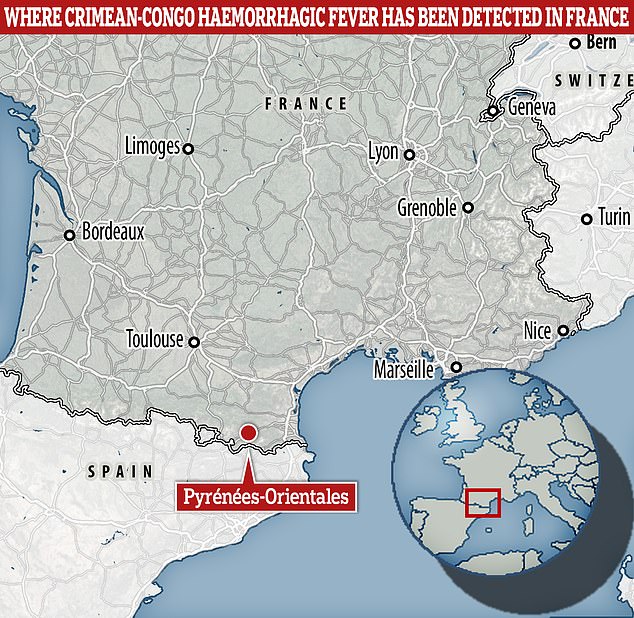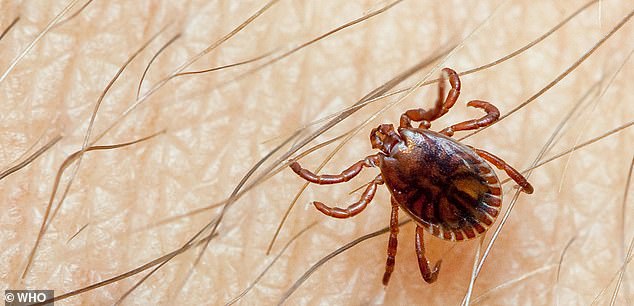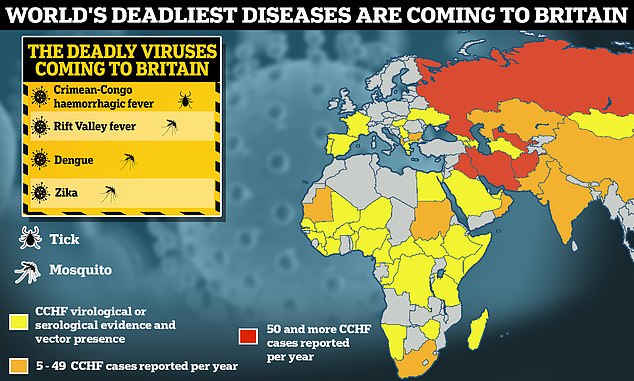Killer ‘eye-bleeding’ virus is found in FRANCE for first time amid fears tick-borne disease will soon make Britain home
A disease thought to kill up to four in 10 infected people has been spotted in France for the first time.
Ticks carrying Crimean-Congo hemorrhagic fever (CCHF) have been found on the country’s border with Spain.
The disease – a cousin of Ebola – is endemic to Africa, the Middle East, Asia and the Balkans, but has been found sporadically in southern parts of Western Europe, such as Spain.
Experts have long warned that climate change will inevitably push the disease to northern Europe. And even Britain could be in danger.

French health authorities have discovered the deadly tick-borne disease Crimean-Congo hemorrhagic fever in animals
Live ticks collected from livestock in the Pyrénées Orientales region were found to harbor the disease.
World Health Organization officials declared CCHF one of nine priority diseases earlier this year because of its potential threat.
CCHF is mainly transmitted to humans through tick bites, but humans can also contract it through contact with bodily fluids from infected patients.
The disease initially has similar symptoms to Ebola, including muscle pain, abdominal pain, sore throat and vomiting.
It can also cause bleeding, usually from the nose or from broken capillaries in the eyes and skin.
Other symptoms of the virus that occur suddenly include fever, dizziness, neck pain and stiffness, back pain, headache, sore eyes and sensitivity to light.
There is no vaccine available, but treatment aims to keep a person alive long enough for their body to fight the infection.
According to the WHO, previous CCHF outbreaks have killed between 10 and 40 percent of those infected.
British health authorities have advised people traveling to the region in France where CCHF was detected to avoid tick bites.

CCHF, a tick-borne virus, has a mortality rate of up to 40 percent and causes symptoms similar to Ebola, according to the World Health Organization (stock image)

A number of diseases carried by mosquitoes and ticks could be on their way to Britain, experts warn, thanks to warming temperatures
They warned that those camping, hiking or interacting with animals in the region are especially at risk of such bites.
CCHF cases have previously been detected in people in France, but so far these have all been imported cases where people were initially infected abroad.
“So far, no autochthonous case (infection acquired on French territory) in humans has been discovered in France,” French government agency Santé publique France said in announcing the discovery.
Health authorities have long suspected that ticks carrying CCHF lurk in both wild and domestic animals in France, based on tests showing that livestock had developed antibodies to the virus.
The CCHF’s announcement directly based on ticks collected from French livestock confirms these fears.
In neighboring Spain, CCHF infections in humans have been reported several times, with 12 cases between 2013 and August last year, four of which were fatal.
Ticks with CCHF were first discovered in Spain in 2010.
In August this year, the EU’s disease watchdog reported two cases of CCHF in North Macedonia, one of which was fatal.
The first and fatal case occurred at the end of July in a farm worker who reported being bitten by a tick.
A second case developed at a health care facility that initially treated the man and subsequently developed symptoms on August 8.
CCHF is primarily transmitted to humans through bites from the Hyalomma marginatum tick.
This tick is about 5 mm in size and has two colored legs with whitish rings at the joints.
Professor James Wood, head of veterinary medicine at the University of Cambridge, told MPs on the Committee on Science, Innovation and Technology in July: ‘Some tick-borne infections, such as Crimean-Congo haemorrhagic fever, are very likely to spread through our country spread in Great Britain. “It’s ticking at some point,” he said.
He even warned that potential outbreaks could initially fly under the radar due to CCHF, a disease that few doctors in this country have experience with.
“The challenge will be early detection because our doctors don’t know what they look like,” he said.
